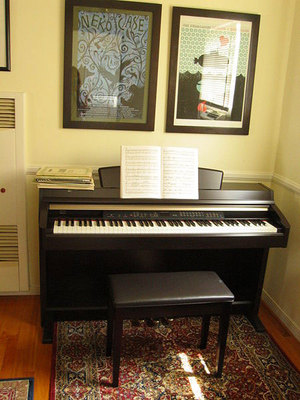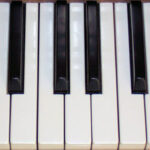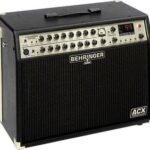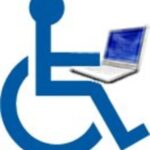There are many well-respected companies worth a look when choosing a digital piano. Unlike other keyboards, a digital piano keyboard seeks to replicate the sound of an acoustic piano, for use on stage or in recordings. Many digital pianos have a multitude of other tones built in as well, but it is for their similarity to the tone of a true piano that they are most-often employed by musicians.
There are two important basic categories in modern digital piano keyboards: hardware-based and software-based digital pianos. There is no “better” or “worse” here, just different products for musicians with different purposes.
First the older, more reliable and more expensive type.
Hardware-Based Digital Piano Keyboards.
Traditionally, since the advent of electronic pianos, the only alternative to lugging a big grand piano around available has been hardware-based digital piano keyboards. The easiest way to classify which digital pianos fall into this type is to ask this question: “Does it make sound on its own?”
Some of the most respected, and reasonably priced, are:
Yamaha YDP-121 88-key Piano
Like many of the more advanced digital piano keyboards, this Yamaha features keys with true hammer-action. Even though the keys, when pressed, are not hitting piano strings, they are connected to hammers similar to those on a real piano in order to have the feel of a real piano keyboard. This accessible Yamaha model is the standard when it comes to mid-range digital piano rigs. It is not, however, as portable as some of the other digital pianos, and is ideal for use in the home.
Korg SP-300 Digital Piano
Korg is known much more for their hardware-based synthesizers and drum controllers than for true digital piano keyboards, but the SP-300 is a winner. It has one of the most accurate and ear-pleasing piano tones from any reasonably priced digital pianos. It is also very portable, and fits easily into most keyboard stands and racks. It has MIDI in and outs, for use with other MIDI devices.
Kawaii MP8 II Professional Stage Piano
The Kawaii MP8 and MP8 II are some of the best digital pianos that money can buy. And they don’t come cheap, either. While the Yamaha YDP-121 will create a tone that to the untrained ear can accurately represent that of a grand piano, the MP8 II is actually approaching the realm of true spot-on tonal accuracy.
If you plan to be using your digital piano keyboard on stage, you will most likely want to go hardware based, due to the much greater reliability these types of digital pianos offer. Unlike anything involving a PC, they don’t generally “crash.” There is very little that can go wrong.
However, in the studio is a very different story…
Software-Based Digital Piano Keyboards
Music recording is slowly but surely making the jump to employing computer software as much as traditional hardware-based instrument solutions. Now that you know about some options when it comes to standalone, or hardware-based digital pianos, here is the other side of the coin.
A digital piano, or keyboard, is said to be “software-based” if it is dependent on another unit, usually a computer or a hardware sound module, to produce a sound. You might ask the question: “What good is an instrument that can’t make any sound on its own?”
The answer is flexibility, and price. When you purchase a hardware-based digital piano keyboard, you are paying for the onboard sounds, amplifier and any other electronics that prepare the instrument for accurately representing the tone of a piano.
With a software-based digital piano keyboard, the price you pay goes into the quality of the keyboard keys, different inputs and outputs, and the ability to interface with audio recording software in complex ways.
Using MIDI messages over a USB or, preferably, FireWire connection, these keyboards can control a multitude of software tones that are housed in one of several audio software suites on your computer. The obvious advantage here is that once you have a PC connection established, your digital piano will be capable of an infinite number of sounds, including the best sampled grand piano tones available.
Here are some of your best bets if you’d like to go the software route.
M-Audio Keystation Pro 88 Controller
This excellent M-Audio MIDI controller keyboard cannot be called a true digital piano, as it cannot be played on stage without the use of external sound modules. However, the fully weighted keys are surprisingly responsive and fairly accurately represent the feel of playing a real piano. The obvious advantage here is that there are countless high-quality digital piano software programs available. The onboard USB Audio Interface has direct monitoring capabilities, which means you can hear what you are playing coming direct through your studio monitors, with no lag.
CME VX8 88 Key USB MIDI Controller Keyboard
Selling for around $1,000, the VX8 is a little pricey for a keyboard that is to be used only in conjunction with MIDI devices or a computer. There are no onboard sounds, but there is no better software based digital piano controller than the VX8. Every single thing you can dream up in the world of software based music production can be controlled and manipulated with the VX8, and the fully weighted, hammer action keys have a great feel too. This one is the standard for production use, or if you are a keyboardist who wants to go the MIDI/PC software based digital piano route.
M-Audio ProKeys 88 Digital Piano and USB Audio Interface
The M-Audio ProKeys 88 combines the near-best of both worlds. M-Audio products are renowned for their ability to interface with all the different software audio creation tools easily and efficiently.
The ProKeys 88 is a digital piano in its own right, with fully weighted hammer action keys and onboard sounds, but has a USB port and onboard sound card as well, so you can use it to control any software-based synth. As a standalone digital piano keyboard, there are many better options, but this added flexibility makes it a top choice.
Whether you go hardware or software, please remember that you get what you pay for. Most pro audio companies do not even offer full-sized (i.e. 88 key) digital piano keyboards, or MIDI controller keyboards, without a certain degree of fit and finish. Software-based digital pianos contain the greatest number of piano tones available, and most musicians agree that you will get a superior tone going the software route, barring recording a top-quality acoustic piano yourself.
Some terms used in this article:
“Fully Weighted” means the keys should feel much more like true piano keys, i.e. they respond to touch as if they were connected to piano wires and have been properly maintained. The manufacturers of the best (most expensive!) digital piano keyboards, including Yamaha and Kawai, take great pride in their ability to accurately represent the all-important “feel” of piano keys, even employing hammers connected to the keys just like those that hit the wires on an acoustic piano.
“Partially Weighted” (or, “Semi Weighted”) means the keys have some feeling of heft to them, and will spring back to center in a manner that does not seem too unrealistic when comparing the digital piano to a standard acoustic piano. Good digital piano keyboards can be found with partially weighted keys for a lot less money then you might think.
The keys on a cheaper partially weighted digital MIDI keyboard are often are of the cutaway style, i.e. the key does not look like a real piano key, but rather sits on a spring, and if you take a peek underneath you can see a cavity there. If you are a serious pianist or keyboardist, these types of digital pianos are not worth your time.
“MIDI” stands for Musical Instrument Digital Interface. MIDI messages, or events, are little bits of data triggered when the user makes certain inputs on a device connected to another MIDI-compatible device, either through a MIDI cable or by way of FireWire, or USB.
These messages can trigger digital piano “sample packs,” or sounds recorded from real instruments and cataloged in a way that will make your playing sound nearly exactly like you were playing a real Steinway Grand Piano, a Fender Rhodes Piano, or even an out-of-tune honkey tonk piano you might find gathering dust in a dark corner of some bar.
Happy music making!






